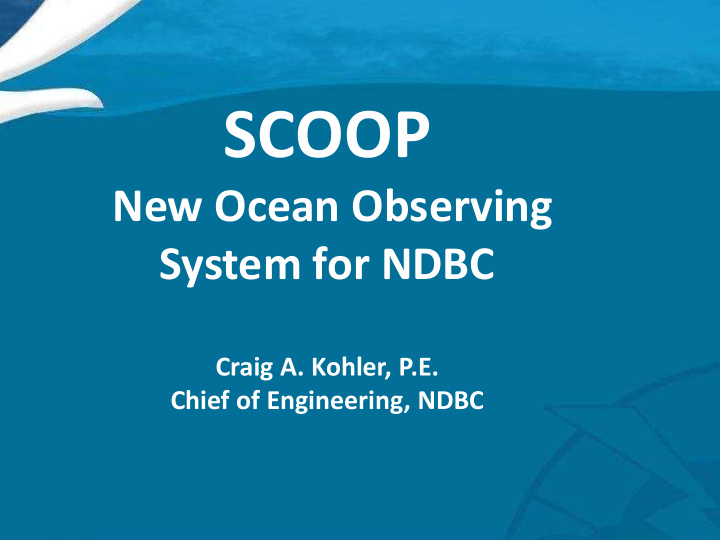



SCOOP New Ocean Observing System for NDBC Craig A. Kohler, P.E. Chief of Engineering, NDBC
Self-Contained Ocean Observations Payload (SCOOP) Background - Typical NDBC Buoy Met Data
Self-Contained Ocean Observations Payload (SCOOP) Future … Present
The Weather Buoy - Today • 600 + hrs Labor to Construct • Complex, Multiple Systems • Weighs 3800 lbs • Can’t Field a 100% Tech Refresh in a Realistic Timeframe • Vulnerable Electronics Opened in Field for Maintenance • Requires Large, Expensive Ships to Service (> 175 ft) • Minimum 6-8 hrs per Service Visit – Mission Aborts • Lots of Opportunities for Mistakes & Failures
The OceanOBS Buoy - Tomorrow Special SCOOP Payloads DART Modular Aux Power Sub-Surface “Empty” Buoy MET- 1 Waves Basic Unit ( NDBC MET-1) Includes MET, Cameras, AIS, and SATCOM • ~ 40 hrs Labor to Construct • Simple, Modular Sealed Systems • Weight – One Person can Lift and Emplace on a Buoy • Deploy Immediately on old & New Buoys – 100% Tech Refresh in a few Years • Units Leave NDBC Sealed and Calibrated – Never Opened in Field • With Smaller “Empty” Buoy Family – More Options for Deployment with Many Vessels • Service Visit in Less than 30 min – Significant Reduction in Mission Aborts • Lack of Opportunities for Mistakes & Failures – due to Sealed Units • Same Unit goes Anywhere – on Legacy or New Buoys, C-MAN Towers, Ships, Land,…….
Legacy WX Buoy Electronics Payload vs SCOOP Prototype Legacy SCOOP
SCOOP Architecture To Shore IRIDIUM GPS SBD Star type network Hub: Coordinates wireless network of modules AIS BuoyCAM Interfaces to shore via Iridium SBD Secondary Hub BuoyCAM : POWER Hub Reports pictures by Iridium RUDICS MET Iridium SBD modem for backup of wireless network EXT AUX MET Modules acquire, process, USER WAVES and send data to Hub(s) OCEAN
Early Prototypes Generation 1 BuoyCAM in Shipping Case Generation 1 BuoyCAM One of First 15 and MET on DART Buoy SCOOP Units In Lab (Sept 2014)
SCOOP Payload Mounted on a legacy 3m Weather Buoy Hull Legacy SCOOP 3 m 3 m Weights > 4000 lbs Need to add 1000 lbs ballast & requires massive cranes In Hull to make Heavy enough
Prototype Deployments – Nov ‘15 Stern A-Frame Recovery On-Deck Assembly
Prototype Deployments – Nov ‘15 Dockside Integrated Hulls Port Crane Deployed
Prototype Deployments – Nov ‘15 SCOOP Retrofit Stern A-Frame Redeployed
E yes on the Ocean E nvironment An Unanticipated Benefit of SCOOP Ability to see images of waves, cloud cover, visibility, surface currents , ship traffic, fishing activities, and wildlife in the remote open ocean and coastlines promises to expand maritime domain awareness and environmental intelligence EXAMPLES • Estimating Waves & Sea State from BuoyCAM Images • Estimating Clouds & Visibility from BuoyCAM Images • Estimating Surface Currents from BuoyCAM Images
Estimating Waves & Sea State from BuoyCAM Images The Beaufort Scale & Guidelines for Visual Observations
BuoyCAM Images vs Instrumentation – Calm Seas
BuoyCAM Images vs Instrumentation – Rough Seas
Estimating Clouds & Visibility from BuoyCAM Images Variation of Ocean Color Vibrancy with small changes in Cloud Cover
Estimating Clouds & Visibility from BuoyCAM Images Reduction of Ocean Color to Gray Scale with Overcast Skies
Estimating Surface Currents from BuoyCAM Images BuoyCAM Images of a Fairly Strong Surface Current “Wake”
SCOOP New Ocean Observing System for NDBC Thank You..Questions ?
Recommend
More recommend